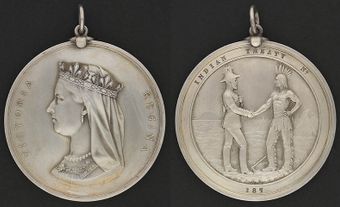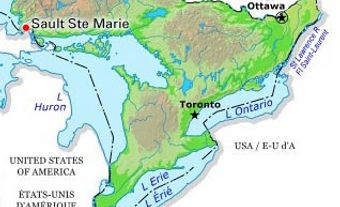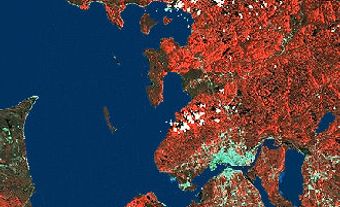Nebenaigoching (also spelled Nebenaigooching, Unbenegooching, or Nabunagoging), or Joseph Sayers, Anishinaabeg Ogima or leader (born c. 1808 at Leech Island, Lake Superior, Upper Canada [ON]; died 1899 at Garden River First Nation, ON). Son of Ogima Waubejechauk (Wabechechacke) and Julia Sayer, Nebenaigoching was a hereditary Crane Clan chief, defender of Anishinaabeg (see Ojibwe) rights, and signatory to the 1850 Robinson-Huron Treaty (see Treaties with Indigenous Peoples in Canada).

Nebenaigoching (Nabunagoging), Shingwaukonse (Chingwackonce) and Menissinowenninne.
Early Life
Like many First Nations in the nineteenth century, not a lot is known about Nebenaigoching’s early years. His father, Waubejechauk, a member of the Crane Clan, was the hereditary chief of the Bawating (meaning “place of the rapids”) region (see Sault Ste Marie) who died fighting with the British during the War of 1812. On 29 June 1819, perhaps in an effort to prevent conflict among potential claims to the hereditary leadership position, the British invested “a boy of eight years [he was approximately 11 at this time] of age ... with the title and marks of distinction belonging to his late father.” His mother Julia Sayers was a member of the Métis community in Sault Ste Marie; her father was a prominent fur trader, Jean-Baptiste Perrault.
It appears that Nebenaigoching grew up in the Bawating region amongst his Anishinaabeg (see Ojibwe) and Métis relations. Nebenaigoching was also known as Joseph Sayers, a surname he adopted from his mother’s family. Nebenaigoching also worked in the fur trade in the Fond du Lac region at the Western end of Lake Superior among his mother’s family and Métis relations prior to the 1830s.
While it is not entirely clear from the records, it appears that Nebenaigoching had a relationship with Annie Shingwauk, the daughter of Shingwaukonse (see Shinguacöuse). A few historical sources claim that Shingwaukonse was Nebenaigoching’s father-in-law. Regardless, in August 1832, in a Roman Catholic ceremony, Nebenaigoching married Marie O’Conner, a Métis woman, in Sault Ste. Marie, Michigan. Two years later, in 1834, Nebenaigoching purchased a small narrow strip lot, that was enclosed, of about 2.5 acres that had a narrow frontage on the St. Marys River (ON). Here, he built a small wooden house and outbuildings where he planted a few crops.
Activism/Community Work
From the 1830s until his death in 1899, Nebenaigoching acted as a hereditary chief for the Crane Clan in the British Sault and acted as a defender of both Métis and Anishinaabeg (see Ojibwe) rights in the Bawating (Sault Ste Marie) region.
Nebenaigoching’s first recorded defence of Métis and Catholic rights at Bawating took place between 1832 and 1838. Nebenaigoching sought to defend both First Nations and Métis rights, while the colonial government had no interest in supporting Métis rights in the nineteenth century. The recently arrived Anglican missionary, William McMurray, who established his mission at the Ermatinger estate in the heart of the Métis community, demanded that the Métis be removed. He accused the Métis and Nebenaigoching of undermining his mission, selling alcohol to First Nations peoples, and engaging in smuggling between the United States and Upper Canada. In seeking the removal of the Catholic Métis to St. Joseph’s Island, McMurray had the support of British Indian Agent Captain Thomas G. Anderson (“Indian Agents” were the British and later Canadian government’s representatives on First Nations reserves from the 1830s to the 1960s). McMurray also destroyed a Catholic chapel under construction. Due to his support of the Métis right to remain on their lots and worship in their chosen manner, Nebenaigoching was deposed as headchief in 1835 by McMurray and Anderson. Despite being ‘deposed’ by British officials, Nebenaigoching remained a recognized leader in the British Sault alongside the newly recognized Shingwaukonse. McMurray’s departure in 1838 temporarily ended the pressure being placed on the Catholics to relocate.
Robinson-Huron Treaty, 1850
Nebenaigoching’s leadership in the 1840s and 1850s was dominated by his efforts to secure a treaty that would protect Anishinaabeg (see Ojibwe) and Métis lands and rights. The need for a treaty was brought about by Canada West’s (between 1841 and 1867, this area was called Canada West) efforts to access the mineral resources of the Upper Lakes without securing a treaty. Nebenaigoching, with his ally and relation Shingwaukonse, resisted the surveying of the Sault by Alexander Vidal in 1846. They submitted a petition in 1847 refusing to relocate from their traditional lands to Manitoulin Island. In 1849, they travelled to Montreal and had an audience with Governor General Lord Elgin about the need for a treaty. In exerting their rights to determine who could access and profit from their lands and resources, Nebenaigoching and Shingwaukonse also leased various islands and lands to Alexander Macdonell, a mineral speculator and lawyer, in 1849. Macdonell was a staunch supporter of Indigenous rights and land claims, in addition to pushing for the economic expansion of Canada West. For Macdonell, the Anishinaabeg claims and aspirations were integral to the success of the colonial state.
Nebenaigoching and Shingwaukonse’s efforts to peacefully engage with the government came to an end when they, along with many Métis and Anishinaabeg supporters, drove miners from Mica Bay (on the shores of Lake Superior) in November 1849. The Mica Bay mine site was established by the Quebec and Lake Superior Mining Association (also known as the Quebec Mining Company) based on an illegal mining lease issued by Canada West. The land had not been surrendered or leased by the Anishinaabeg to the Crown as was required by the Royal Proclamation of 1763. After Mica Bay, Nebenaigoching and other leaders quickly surrendered themselves to authorities. He was bound and sent to Toronto for trial. Along with Shingwaukonse, Nebenaigoching was released after Chief Justice Sir John B. Robinson determined that the arrests were illegal. The Mica Bay Incident was a turning point, forcing Canada West to begin treaty negotiations with local Indigenous groups in August-September 1850.
Throughout the 1850 Robinson-Huron treaty negotiations, Nebenaigoching consistently demanded security of lands, access to resources, and Métis inclusion. While his efforts failed to see the Métis specifically included in the treaty as well as a higher annuity and guaranteed protection of mineral access, he did manage to retain Whitefish Island in the St. Marys River as a fishing station for his people and the creation of a large reserve on Batchawana Bay.
After the 1850 treaty was signed, Nebenaigoching focused his efforts on seeing the terms of the treaty implemented, economic development, as well as continued protection of land and rights. For instance, in 1851 he requested 100 pounds of fishing thread for nets from Indian Agent George Ironside, Jr.
Later Life
By 1857, the federal government sought further land surrenders on behalf of mineral speculators, fishing and timber merchants. Nebenaigoching’s resistance to further land surrenders led to his leadership being threatened briefly by the actions of government officials such as Crown Lands Agent Joseph Wilson. Eventually, in 1859, Nebenaigoching signed the Pennefather Treaty that surrendered most of the Batchewana reserve created in 1850. After Pennefather, his people reserved some lands and fishing stations as well as securing a promise from William Gibbard, the government’s fishery inspector, concerning fishing rights. Once the 1859 treaty was signed, however, Gibbard and the government ignored the promises.
After the questionable surrender of the Batchawana reserve in 1859, Nebenaigoching and his band moved onto Garden River First Nation’s reserve. Despite promises of equally sharing the reserves resources Nebenaigoching’s band were gradually excluded from accessing its resources. After the 1859 move, Nebenaigoching’s band retained its own chief and band council, maintained a separate band account, and continued to receive treaty annuities as a band. As the populations of Garden River and Batchawana Bands increased, Batchawana increasingly demanded its own land base. Additionally, debates between band members about whether Nebenaigoching or Shingwaukonse was the last hereditary principal chief in the Sault also contributed to a sense of separateness. These factors eventually led the Batchewana Band Council to purchase a mining location from the Rankin Mining Company on the eastern edge of Sault Ste. Marie in 1939. These lands were formally recognized as Rankin Reserve 15D in 1952.
Nebenaigoching valued educational opportunities for subsequent generations.To this end in 1874 he worked with Edward F. Wilson, founder of the Shingwauk Home, to establish a “teaching wigwam” at Batchewana Bay.
In 1875, Nebenaigoching, alongside Shingwaukonse’s sons, Ogista and Buhkwujjenene, demanded that the government repeal the 1869 Gradual Enfranchisement Act (see Indigenous Women and the Franchise) that enfranchised Status Indian (see Indian Act) women who married Euro-Canadians. The Act sought to enfranchise women who married outside of their Indigenous community, eased the enfranchisement of male band members, imposed a blood quantum requirement, allowed for the imposition of a western style governance system, and allowed enfranchised Status Indians to take a portion of reserve lands while imposing western patriarchy on communities. It was these efforts to undermine Anishinaabeg women and sovereignty that Nebenaigoching opposed. Ultimately, Nebenaigoching and other leaders’ work to resist the enfranchisement of women, the ability to determine their membership, and other issues were unsuccessful in the short term. However, in the long term their efforts to secure reserve lands ensured a land base for their communities.
In the 1880s, Nebenaigoching fought to protect lands. In 1882, for example, he contested the failure to properly survey the now surrendered Batchawana reserve (surrendered in 1859). The following year, in 1883, Nebenaigoching and Ogista, the chief of Garden River, objected to the seizure of lands by mining speculator Arthur Rankin. Nebenaigoching continued to resist government land policies as well as its spending of band capital accounts. While unsuccessful in preventing the seizure of most of the land in 1883-84, Garden River successfully settled this claim with Ontario and Canada in 2019.
Nebenaigoching also fought for the rights of other Indigenous nations. Throughout the second half of the nineteenth century, Chief Nebenaigoching and other leaders in the Sault resisted government efforts to strip those individuals determined to be American First Nations or Métis from the Batchewana and Garden River annuity lists in the 1850s, 1860s, 1870s, 1880s, and 1890s. When the province of Ontario sought to reduce band membership lists in the early 1890s, Nebenaigoching refused to cooperate with the investigator, E. B. Borron. This refusal limited provincial efforts to remove Métis and others from the band lists in an unprincipled effort to reduce the provinces’ annuity obligations under the terms of the 1850 Robinson-Huron Treaty.
Legacy
Nebenaigoching is remembered as a powerful and key chief in the Sault Ste. Marie region who defended both Métis and Anishinaabeg (Ojibwe) rights. He is a founder of the Batchewana First Nation reserve and signatory to the 1850 Robinson-Huron Treaty. He also served as a unifying force for Anishinaabeg and Métis interests in the Bawating region. For example, Nebenaigoching and Shingwaukonse’s efforts to include the Métis in the 1850 Robinson-Huron Treaty and the statements made by the Crown’s treaty commissioner, William B. Robinson, contributed to the recognition of Métis hunting rights through the Powley Decision, 2003.
In the long term, Nebenaigoching and other Anishinaabeg leaders provided a basis to continue to resist Canadian colonial policies, as well as ensure a cultural and political resurgence in the modern age. Chief Nebenaigoching died in January 1899 and is buried at Garden River First Nation.

 Share on Facebook
Share on Facebook Share on X
Share on X Share by Email
Share by Email Share on Google Classroom
Share on Google Classroom












